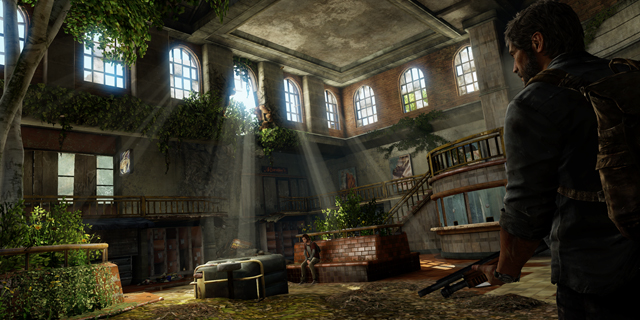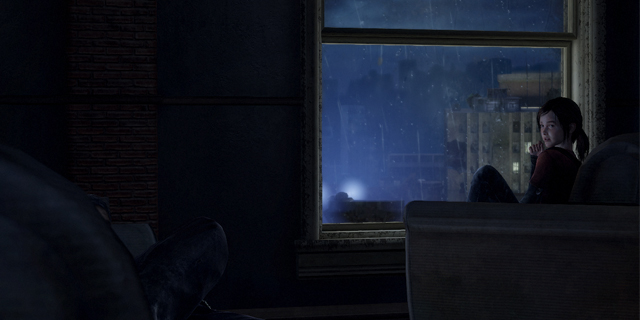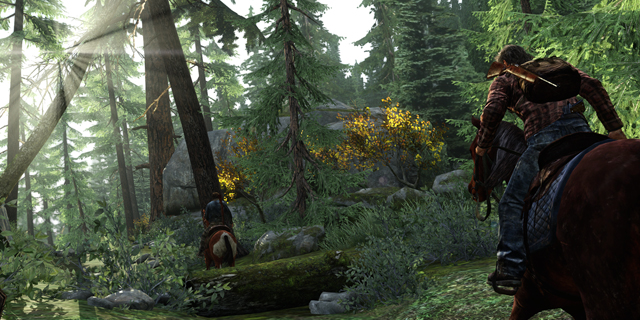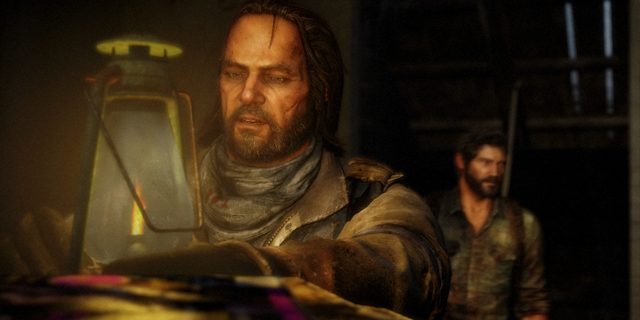Naughty Dog’s track record as of late has been spectacular, delivering three great games in the Uncharted series. While it seemed like making a fourth was the obvious move, the team decided to try something a little different. The Last of Us, a post-apocalyptic action game, is as far from the norm for the studio as you can get. It swaps out Nathan Drake’s breezy adventures with something a little more grounded. Thankfully for us, it proves that Naughty Dog’s talent as a developer is still as strong as ever.
Taking place twenty years after the outbreak of a fungus that has turned the majority of America’s population into flesh-hungry creatures, The Last of Us follows Joel and Ellie, two survivors whose lives connect through unfortunate circumstances. The nature of their meeting and the ultimate goal of their adventure together are better left discovered for yourself, but these two characters and their relationship is what ties this tale together, and it’s executed magnificently.
Joel, an older man who was alive during the initial outbreak, views the world differently than 14-year-old Ellie, who was born into this chaos. During their travels, the two often discuss each other’s lives, with Ellie’s natural curiosity about the world before the infected often shining through. These are two strong, albeit flawed, characters, but you quickly become attached to them. While there are other matters present in The Last of Us’ story, without the relationship between Joel and Ellie, a lot of it would fall flat. Like similar post-apocalyptic games, it becomes less about the world or the dangers in it and more about the people who are desperate to survive.

The world itself is a character as well, with many stories to tell. While you will find a good number of diaries and other notes throughout the world that detail the lives of the people who took up refuge in these desolate places before you, they aren’t essential. The story-based collectible trend is one that tends to get a little old, but The Last of Us still manages to present the world in immaculate detail. You don’t need a journal entry to tell you what happened at a given location. The writing on the wall, the blood stains on the floor; those are the things that tell you all you need to know. And, like with any good post-apocalyptic story, these moments aren’t necessary to flesh out the world; they add just enough subtle elements to keep you exploring.
It’s hard to talk about the world without speaking about the visuals. With all of the current hubbub about next generation consoles, it’s hard to imagine games on this current hardware standing out. Despite that, The Last of Us manages to do so by pushing the PS3 to its limits. The game is stunning; even the smallest aspects are fleshed out in immaculate detail. It presents a world full of death, and yet covered in life, as plants begin to retake the land once inhabited by humans. Top this off with a stellar soundtrack from Gustavo Santaolalla, and you have a game that almost speaks for itself.
As you might expect, a world ravaged by infected means you might need to deal with them in one way or another. You’ll often come across groups of them and, due to your limited resources, the emphasis on stealth is key. The two types of infected you’ll find yourself running into the most are runners, basic enemies that attack in swarms but are relatively easy to take down, and clickers. Clickers are blind, but can detect sound easily (making a disturbing clicking noise as they walk, as their name would suggest), meaning you’ll have to move very carefully when dealing with groups of them. You can throw bottles or bricks to distract them or even take them down from behind if given the opportunity. If spotted, clickers can kill you immediately, making avoiding them altogether the more preferable solution.

Other useful materials
On top of materials for crafting, you will also gather scraps which are used to upgrade your weapons, giving you a chance to increase the reload speed, clip size or power of each gun, among other things. You also gather medicine that acts as upgrade points for Joel, giving you a chance to increase your health, healing speed or crafting ability.
You will also need to worry about human enemies, and groups of them are arguably more dangerous than the infected. Like with infected, most encounters with humans can be dealt with through stealth. Many of these encounters are large, multi-tiered areas full of several potential paths to take. No matter if you’re taking on humans or infected, these situations are usually tense, keeping you on your toes at all times. Thankfully, Joel has learned to hone his hearing and by holding R2 you can easily identify where enemies are by the sounds they are making. If they are silent, you won’t see a thing, but this is a handy ability when, for example, you are surrounded by clickers and need to find a viable path around them.
Eventually you learn to deal with your limited resources and, when confronted, will make the most of what you have at your disposal. It’s an excellent system that teaches you to value your resources and, over time, it will make the game’s more difficult scenarios manageable. You do need to rely on gathering resources at all times though, giving you plenty of opportunity to scavenge for supplies in areas you may otherwise ignore. You will run into situations where there is a house that could potentially be full of supplies, but is surrounded by infected. Do you attempt to sneak past them, potentially using resources just to gather more, or do you ignore it completely? You’ll be asking yourself this a lot during your many hours of game time.

With these supplies you gather you can craft items, such as med kits (which are necessary to heal your wounds since there is no regenerating health), shivs (useful for taking out enemies from behind) and even explosives (such as molotovs and nail bombs). All of this happens in real time, making it difficult to craft while in the middle of combat. Once again, this keeps you on your toes, making sure you are constantly checking your supplies before entering areas full of enemies.
Not every situation can be dealt with using stealth. Combat in The Last of Us is fairly basic, but just effective enough to keep you alive. Unlike most games with guns, you have very limited resources, so it’s always recommended to find a path around the enemy rather than confronting them head-on. And when you do need to rely on your weapons, you’ll be counting every single bullet and doing your best to not miss a shot.
If you’ve played Uncharted before, the aiming and shooting won’t feel too dissimilar. The guns all pack a punch and due to your limited ammo, you’ll often find yourself using most of the weapons at your disposal, keeping things varied. Some of the weapons you have equipped include basic handguns, a rifle, a shotgun and even a bow, all of which are handy in most encounters. You can rely on melee, either with your bare hands or with a variety of different weapons, such as wooden planks or metal pipes, but if you’re surrounded you won’t last too long in a one-on-one fist fight.

With this being a game about survival, violence is everywhere, and it’s one of The Last of Us’ most effective aspects. It’s not uncommon in games these days, and yet this emphasis on survival also heavily emphasizes what is necessary in order to survive. This is communicated through the gameplay in remarkable and disturbing ways. Each gunshot or punch feels impactful and the violence more intimate than your average action game, leaving you with the cold reality that, yes, it was unfortunate, but necessary. Combine that with the game’s overwhelming intensity, and this is the first title I’ve played in a long time that made me put down the controller for a while, simply because I needed to catch my breath.
Thankfully, the game presents you with a number of quiet moments, providing some refuge from the intensity of combat. These moments also provide Joel and Ellie a chance to explore and chat about their lives and experiences with each other. These moments, the ones focused on reflection of their past and hopefulness for their future, are the ones that stood out to me the most and made everything that followed more powerful as a result.
The Last of Us also features competitive multiplayer, something I initially thought would be easy to dismiss. Surprisingly enough, it works, taking the best aspects of the game’s single-player experience and adding them successfully to team-based multiplayer. When you first start, you are given one of two factions to choose from. There, you are thrown into a group of survivors, with their survival depending on how well you do during each match you play.
While each individual multiplayer match plays out like a variation of your traditional team deathmatch, every win or loss adds up to how well your overall faction is doing. And as time passes, you will either find yourself surviving or slowly dying off. As your group grows, the demand for more resources (from more wins in multiplayer) increases, and the more difficult it becomes to stay alive. During matches themselves, you rely on gathering resources and crafting items as you would solo, but you will always need to watch your back. It’s a brilliant combination of the game’s themes and mechanics, in a multiplayer mode that is both effective and addictive.
The Last of Us isn’t for everyone. Its methodical pace, emphasis on stealth and extreme violence might turn many players away, but it’s an emotional tale of survival, wrapped in excellent mechanics and a brilliant world that is well worth experiencing. Above all else, it proves that you can tell a mature story and craft a game around that story with mechanics that only support the weight of its themes. It is a gaming experience you won’t soon forget.
Pros: Brilliant (and brutal) story, well-crafted environments, surprisingly-fun multiplayer
Cons: Sometimes-methodical pacing and brutal violence is not for everyone







































